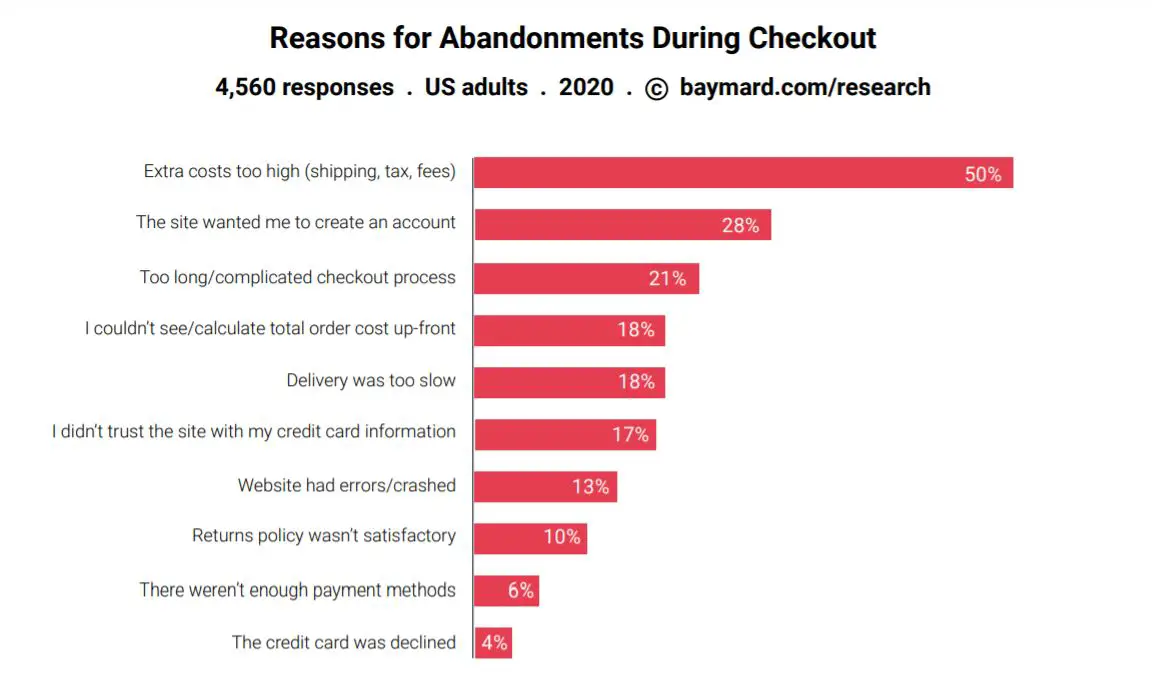When you shop online, you do not have the physical product in front of you. You rely on the product information available on the site to make the buying decision. From images, product dimensions, delivery options, availability, price, and reviews, shoppers are evaluating options based on the product information displayed on the site. Any discrepancies here can lead to a mismatch in expectations and ultimately contribute to churn or shopping cart abandonment.
Top reasons for cart abandonment
Incomplete or inaccurate product information, price variation at checkout, payment glitches, discount code failures, delay in response, and unexpected usability issues can negatively impact the online shopping experience and lead to cart abandonment.
Some of the top reasons for cart abandonment include:
- Unexpected costs like shipping during checkout
- Lack of option to check out as a guest without creating an account
- Complex and confusing check out process
- Slow delivery timelines
- Security concerns while using credit card
- Website glitches
- Unsatisfactory return policies
10 Ways to reduce shopping cart abandonment
Nearly 70% of online shoppers abandon their carts. By improving checkout rates, the e-commerce industry can recover up to $260 Billion. Here are some ways in which brands can reduce shopping cart abandonment.
1. Automate resolution workflows and messages
Online shoppers don’t have a shop owner or manager to help out in case something goes wrong. Any issues especially when it comes to payment gateways such as a delay in getting notifications or errors in authentication can lead to customer dissatisfaction. Getting a prompt response and timely support is crucial to protect the customer’s faith in an e-commerce brand.
Artificial intelligence and machine learning algorithms make it possible to monitor billions of rapidly changing metrics in real-time and quickly identify the root cause of problems such as pricing errors or faulty coupon codes. With faster and accurate insights into the problem areas, it is possible to automate the resolution workflow to quickly send alert messages and remediate issues to reduce shopping cart abandonment.
2. Be transparent with charges
Display all costs including extra charges and shipping charges on the product page itself. By being upfront about the total charges, you can set the right pricing expectation to the users from the beginning itself to avoid cart abandonment.
3. Provide guest checkout option
Provide the option for guest checkout without the lengthy steps of account creation to make it easier for new visitors to place an order on your website.
4. Show a progress indicator
You can also simplify the check out process with a simple and easy to understand progress indicator that will allow users to know if their orders are getting successfully placed.
5. Offer fast delivery options
Delivery times matter especially during the holiday season when people are gifting their peers and family. One way to avoid disappointing shoppers is to be clear and transparent about the estimated delivery time. Additionally, you can also provide an option for fast delivery at an additional cost. Often, people are ready to pay extra charges for faster delivery than wait for weeks for products to arrive.
6. Give ample payment options
Offer multiple payment options to users on your e-commerce site. Additionally, you can build trust and credibility with security logos, trust badges, and transaction forms for payment pages. 75% of customers do not complete a purchase if they don’t recognize trust logos. Make sure to display the website trust badges on your site.
7. Monitor conversion path of users
With autonomous anomaly detection, enterprises can monitor the conversion path taken by users in real-time to spot and remediate hidden roadblocks that lead to cart abandonment in the first place. By monitoring the conversion path, you can spot hidden roadblocks and get insights on customer pain points to make the whole navigation and checkout process more seamless.
8. Fix website errors
Augmented analytics also allows you to monitor the e-commerce application in real-time to detect and remediate website issues such as slow loading pages that will deter online shoppers.
9. Keep your return policy simple
Create a flexible and simple return and refund policy that inspires trust. Provide clear information about the warranty, return and refund policies so that users can easily know the next steps to follow in case they are not happy with their purchase.
10. Bring back cart abandoners with re-marketing campaigns
You can retarget cart abandoners with display ads, and customized email campaigns to bring them back to the product page. These campaigns can include updates on new stock availability and price drops to pique the interest of shoppers and encourage them to make a purchase on your website.
Want to Increase E-commerce Conversion Rates?
Source link











Leave a Reply